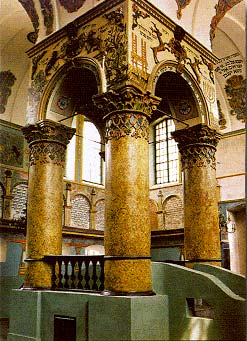| |
|
The
Castle Museum |
The Synagogue

The first
mention of Jews in Lancut comes from 1563. At the beginning of the seventeenth
century the Jewish community already had its own synagogue, built of wood.
In the early twentieth century 40% of the town's residents were Jews. In 1939
there were 2,753 living here. After the Germans took the town, some of the
Jewish population were deported to Soviet occupied zones; the rest were shot to
death in August and September 1942.
The Baroque synagogue that exists today, decorated
with rich polychromy and stucco work, was built in place of the wooden synagogue
in 1761. Scrupulously restored in the 1960's, today it houses a museum of
Judaica.
Two famous Hasidic leaders are associated with Lancut. Elimelech (Mailech;
1717-1780), taught here before he settled for good in nearby Lezajsk, as did his
student, Jacob Isaac (Jakub Izaak Horowic; 1745-1815), known as the Seer of
Lublin.